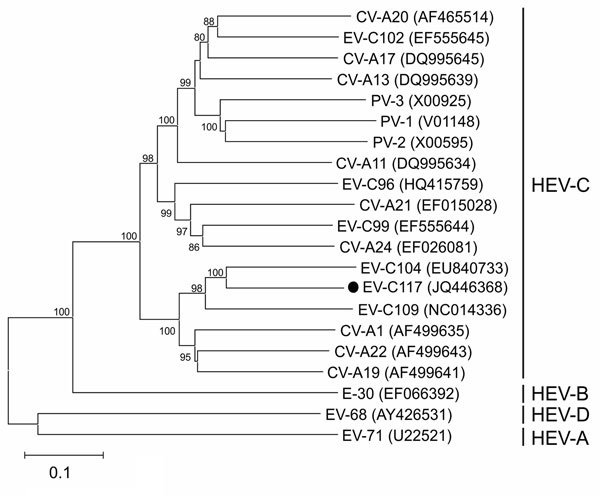Volume 18, Number 11—November 2012
Letter
Novel Human Enterovirus C Infection in Child with Community-acquired Pneumonia
Figure

Figure. . . Phylogenetic relationships of human enterovirus C (HEV-C) and the new strain EV-C117 (dot), as determined on the basis of the complete capsid protein coding region sequences. The phylogeny of the nucleotide sequences was reconstructed by using maximum likelihood methods with the Tamura 3-parameter model as the evolutionary model rates among sites were heterogeneous, and gamma distribution was used for the relative rate (7). Branch support was assessed by means of bootstrap analyses of 1,000 replicates; a bootstrap value of 70% was used as the cutoff point for cluster analysis. Enterovirus strains EV-68 and EV-70 were used as the outgroup. Scale bar indicates nucleotide substitutions per site.
References
- Pallansch MA, Roos R. Enteroviruses: polioviruses, coxsackieviruses, echoviruses, and newer enteroviruses. In: Knipe DM, Howley PM, eds. Fields virology, 5th ed. Philadelphia: Lippincott Williams & Wilkins; 2007. p. 839–93.
- Oberste MS, Maher K, Flemister MR, Marchetti G, Kilkpatrick DR, Pallansch MA. Comparison of classic and molecular approaches for the identification of untypeable enteroviruses. J Clin Microbiol. 2000;38:1170–4.PubMedGoogle Scholar
- Brown BA, Maher K, Flemister MR, Naraghi-Arani P, Uddin M, Oberste MS, Resolving ambiguities in genetic typing of human enterovirus species C clinical isolates and identification of enterovirus 96, 99 and 102. J Gen Virol. 2009;90:1713–23. DOIPubMedGoogle Scholar
- Pabbaraju K, Wong S, Tokaryk KL, Fonseca K, Drews SJ. Comparison of the Luminex xTAG respiratory viral panel with xTAG respiratory viral panel fast for diagnosis of respiratory virus infections. J Clin Microbiol. 2011;49:1738–44. DOIPubMedGoogle Scholar
- Lu X, Holloway B, Dare RK, Kuypers J, Yagi S, Williams JV, Real-time reverse transcription–PCR assay for comprehensive detection of human rhinoviruses. J Clin Microbiol. 2008;46:533–9. DOIPubMedGoogle Scholar
- Nix WA, Oberste MS, Pallansch MA. Sensitive, seminested PCR amplification of VP1 sequences for direct identification of all enterovirus serotypes from original clinical specimens. J Clin Microbiol. 2006;44:2698–704. DOIPubMedGoogle Scholar
- Tamura K, Peterson D, Peterson N, Stecher G, Nei M, Kumar S. MEGA5: molecular evolutionary genetics analysis using maximum likelihood, evolutionary distance, and maximum parsimony methods. Mol Biol Evol. 2011;28:2731–9. DOIPubMedGoogle Scholar
- Rahamat-Langendoen J, Riezebos-Brilman A, Borger R, van der Heide R, Brandenburg A, Schölvinck E, Upsurge of human enterovirus 68 infections in patients with severe respiratory tract infections. J Clin Virol. 2011;52:103–6. DOIPubMedGoogle Scholar
- Piralla A, Rovida F, Baldanti F, Gerna G. Enterovirus genotype EV-104 in humans, Italy, 2008–2009. Emerg Infect Dis. 2010;16:1018–21. DOIPubMedGoogle Scholar
- Esposito S, Daleno C, Prunotto G, Scala A, Tagliabue C, Borzani I, Impact of viral infections in children with community-acquired pneumonia: results of a study of 17 respiratory viruses. Influenza Other Respi Viruses. Epub 2012 Feb 13. DOIGoogle Scholar
Page created: October 16, 2012
Page updated: October 16, 2012
Page reviewed: October 16, 2012
The conclusions, findings, and opinions expressed by authors contributing to this journal do not necessarily reflect the official position of the U.S. Department of Health and Human Services, the Public Health Service, the Centers for Disease Control and Prevention, or the authors' affiliated institutions. Use of trade names is for identification only and does not imply endorsement by any of the groups named above.